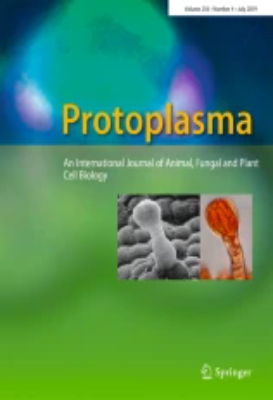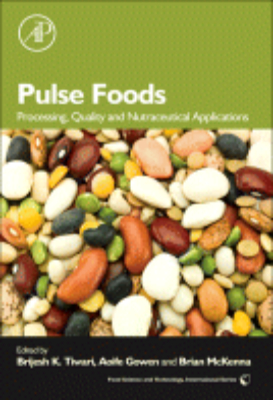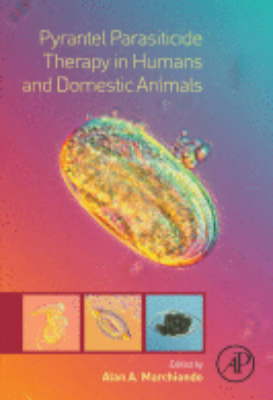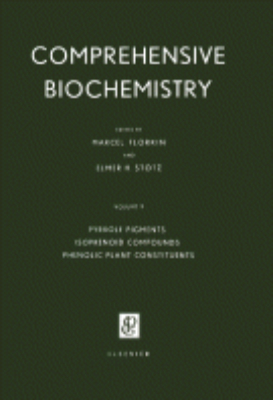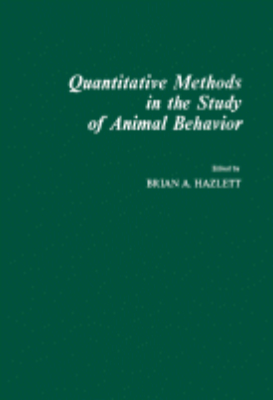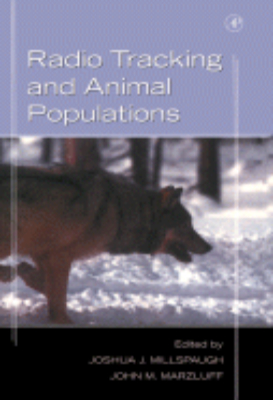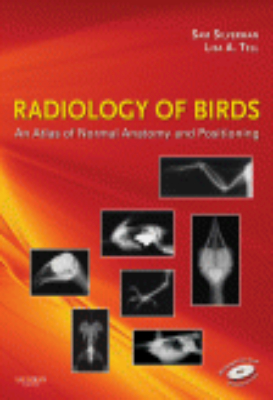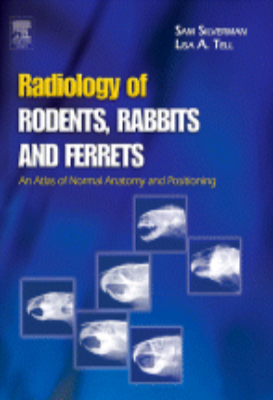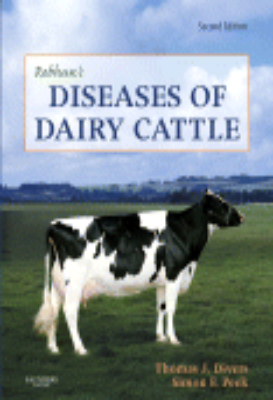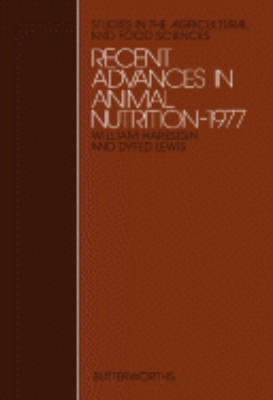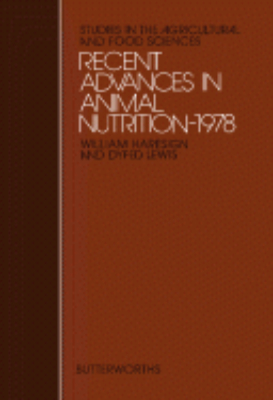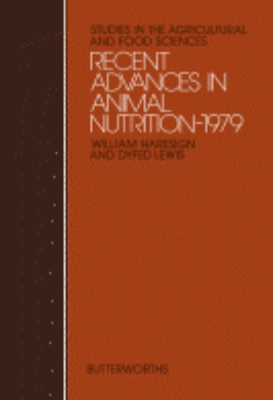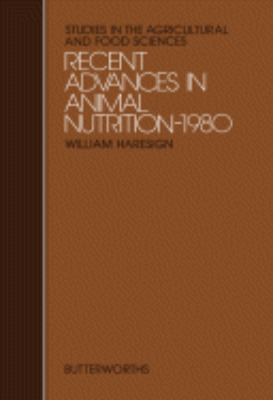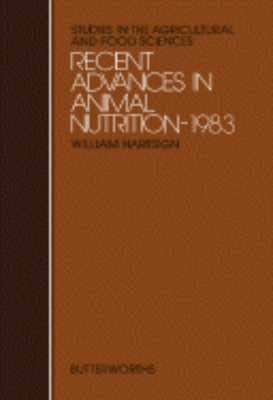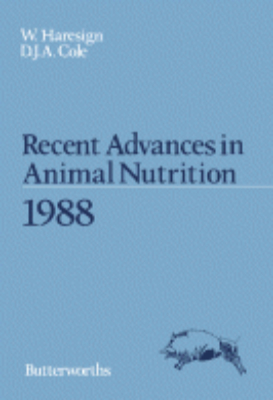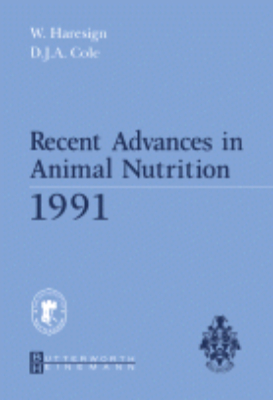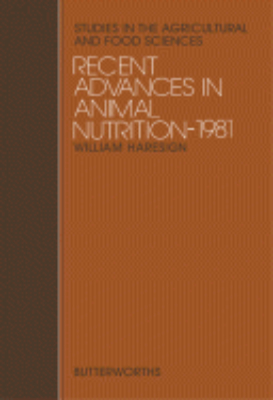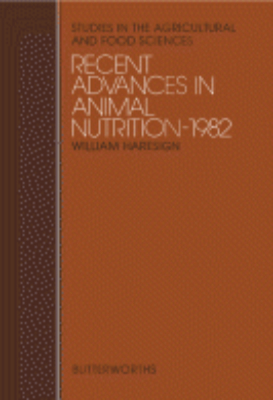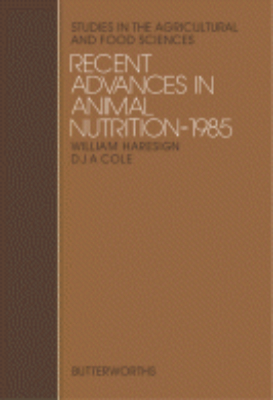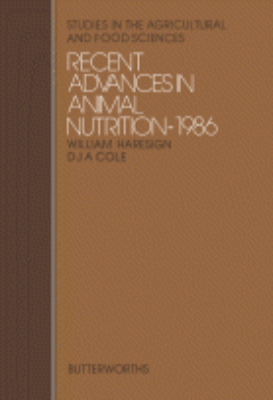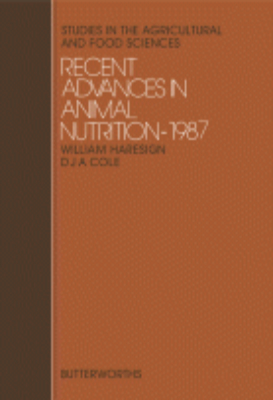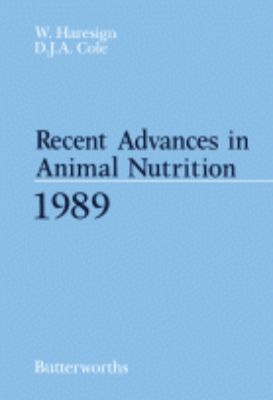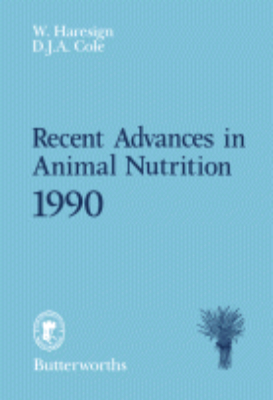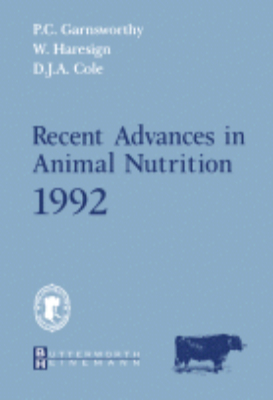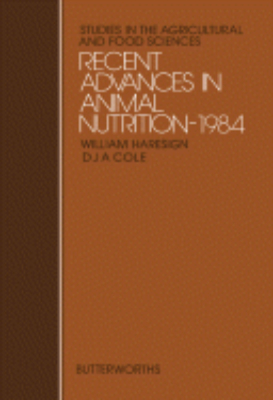E-Resources
Pulse Foods
"Pulses are nutritionally diverse crops that can be successfully utilized as a food ingredient or a base for new product development. They provide a natural food grade ingredient that is rich in lysine, dietary fiber, complex carbohydrates, protein and B-vitamins suggesting that pulses can provide a variety of health benefits such as reducing heart disease and diabetes. Interest in the use of pulses and their ingredients in food formulations is growing and several factors are contributing to this drive. Pulse Foods: Processing, Quality and Nutraceutical Applications is the first book to provide up-to-date information on novel and emerging technologies for the processing of whole pulses, techniques for fractionating pulses into ingredients, their functional and nutritional properties, as well as their potential applications, so that the food industry can use this knowledge to incorporate pulses into new food products. Key Features. First reference bringing together essential information on the processing technology of pulses. Addresses processing challenges relevant to legume and pulse grain processors. Delivers insights into the current state-of-art and emerging processing technologies. In depth coverage of developments in nutraceutical applications of pulse protein and carbohydrate based foods"
Pyrantel Parasiticide Therapy in Humans and Domestic Animals
"Pyrantel Parasiticide Therapy in Humans and Domestic Animals presents a single source history and reference on the parasiticide activity and pharmacology of the tetrahydropyrimidines and their salts in humans and domestic animals, also collating evidence that resistance to pyrantel has developed in human and domestic animal nematodes. Other books of this nature have been compiled historically for specific anthelmintic compounds, but none has been written to date for the pyrantel family of drugs. Pyrantel, a nicotinic receptor agonist, has been used in domestic animal and human medicine since the 1970s to control two important nematode groups, the hookworms and the roundworms. Given the zoonotic potential of these parasites, pyrantel has served a dual role in helping to protect the health of both domestic animals and the public for more than 45 years. Key Features. Easy-to-use reference guide on the anthelmintic pyrantel for clinicians, parasitologists, and researchers in human and veterinary medicine. Addresses current issues of resistance, along with combination uses against anthelmintic resistant parasites. Presents useful, authoritative information (chemical, pharmaceutical, clinical, etc.) for the pyrantel family of compounds. Includes a discussion on pyrantels potential role in combination therapies. Provides cutting-edge material, and will be an evolving area of scientific discussion of treatment options in the future"
Quantitative Methods in the Study of Animal Behavior
Quantitative Methods in the Study of Animal Behavior covers a symposium on quantitative methods in behavior. In this book, mathematics is used in two ways statistical approaches (techniques that describe the main patterns and variability of behavior patterns) and model building. Composed of six chapters, the book opens with a discussion on the three areas of classical ethology social dominance, behavioral taxonomy, and behavioral variability. The following chapter focuses on the information theory as an ethological tool. In Chapter 3, application of multivariate analyses to diverse ethological data is discussed. The next part of the book discusses more in detail the animal behavioral patterns, relationships, and sequences. The book is a good reference for various fields such as biological science, marine science, and zoology. Students, teachers, scientists, and researchers interested in the aspects of statistics and patterns in animal behavior can make use of this book as a valuable resource.
Radio Tracking and Animal Populations
Radio Tracking and Animal Populationsis a succinct synthesis of emerging technologies and their applications to the empirical and theoretical problems of population assessment. The book is divided into sections designed to encompass the various aspects of animal ecology that may be evaluated using radiotelemetry technology - experimental design, equipment and technology, animal movement, resource selection, and demographics. Wildlife biologists at the leading edge of new developments in the technology and its application have joined forces.
Radiology of Birds
Use this atlas to interpret radiographic images and make accurate diagnoses! Hundreds of high-quality images clearly demonstrate normal avian anatomic and radiographic features in a wide variety of species so that you can recognize abnormal features. This book includes detailed directions for patient positioning along with radiographic exposure guidelines, ensuring that you obtain the highest quality diagnostic images.
Radiology of Rodents, Rabbits, and Ferrets
This text offers essential coverage of normal radiographic anatomy of small mammal species including rabbit, ferret, guinea pig, chinchilla, hamster, mouse, and rat. Historically used as laboratory animals, these pocket pets now have increasingly higher companion animal value and owners are more commonly seeking medical care for them. This resource is designed to help veterinarians meet increasing client demand for services. It provides an understanding of normal anatomic and radiographic features that will help clinicians more easily identify abnormal features to reach an accurate diagnosis.
Rapid Mixing and Sampling Techniques in Biochemistry
Rapid Mixing and Sampling Techniques in Biochemistry focuses on the applications of rapid reaction techniques to biochemical problems, including mechanical disturbance, cavitation, and spectroscopic evaluation. The selection first offers information on flash photographs of jet collision phenomena, curved coaxial mixer with two circular inlet channels, and ten jet mixers. Topics include cavitation and mechanical disturbance, efficiency of mixing, operation of the flow apparatus, and mixing tests. The book also ponders on cavitation in rapid flow apparatuses, as well as avoidance of cavitation and description of the flow apparatus. The publication takes a look at ball mixers, multiple rapid mixing of micro-samples by a gun-type projection system and its rapid spectroscopic evaluation, and thermal stopped-flow apparatus. The book also elaborates on pulsed flow apparatus, photochemical activation apparatus using flash tubes, and experimental evaluation of the Bray rapid freezing- technique. The selection is a valuable source of data for readers interested in rapid mixing and sampling techniques.
Rebhun’s Diseases of Dairy Cattle
REBHUN'S DISEASES OF DAIRY CATTLE, 2nd Edition is your all-in-one guide to bovine disease management. With thorough, up-to-date coverage of differential diagnosis methods, surgical and therapeutic treatment options, and prevention strategies, it provides vital information for battling bovine diseases in both dairy and non-dairy cattle. The book is organized by body system for quick, convenient reference, and this new edition meets the growing need for management of both diseases of individual cows and problems affecting whole herds.
Recent Advances in Animal Nutrition 1977
Recent Advances in Animal Nutrition-1977 presents papers that tackle the various areas of concerns in raising ruminants. The book contains a total of 11 studies that examine the factors affecting rumen fermentation. The text first covers EEC and feed compounding, and then proceeds to discussing the aspects of the biochemistry of rumen fermentation. Chapter 3 examines the influence of nitrogen and carbohydrate inputs on rumen fermentation. Chapter 4 talks about reducing the rate of ammonia release through alternative non-protein nitrogen sources. The fifth chapter describes the potential of protected proteins in ruminant nutrition. Next, the book discusses the manipulation of rumen fermentation. Chapter 7 covers the application of non-protein nitrogen, protected proteins, and rumen fermentation control. The next two chapters deal with broilers and turkeys. The eleventh chapter talks about predicting growth response in pigs, while the last chapter covers fish nutrition. The book will be most useful to both researchers and practitioners of animal related disciplines, such as agriculture and veterinary medicine.
Recent Advances in Animal Nutrition 1978
Recent Advances in Animal Nutrition-1978 is a collection of papers that tackles various topics concerning livestock feeding. The book presents a total of 12 materials that cover different livestock, particularly poultry, pigs, and dairy cows. The text first covers poultry feeding related topics, such as the factors affecting amino acid requirements of meat birds; protein-energy interactions in broiler and turkey rations; and nutrition-disease interactions of leg weakness in poultry. Next, the book tackles pig feeding concerns, including amino acid nutrition of the pig; energy requirements of the growing pig; and processing and preparation of cereals for pig diets. The remaining chapters discuss topics relevant to dairy cow diet, such as ratios for high-yielding dairy cows; concentrate feeding of dairy cows; and complete-diet feeding of dairy cows. The text will be most useful to both researchers and practitioners of animal related disciplines, such as agriculture and veterinary medicine.
Recent Advances in Animal Nutrition 1979
Recent Advances in Animal Nutrition-1979 is a collection of studies that tackles the nutritional concerns of both ruminant and non-ruminant livestock. The book presents a total of 11 materials that cover the measurement of nutritional value of feeds up to the inter-relationships between nutrition, body condition, and reproduction of livestock. The text first tackles the nutritional availabilities in livestock diets, and then proceeds to dealing with covering topics related to energy value of feeds, such as energy evaluation of cereals for pig diets; developments of the metabolizable energy system for ruminants; and predicting the metabolizable energy value of feeds for ruminants. The book also covers the effects of cereal processing and growth stimulants on the efficiency of ruminant production. The selection will be most useful to both researchers and practitioners of animal related disciplines, such agriculture and veterinary medicine.
Recent Advances in Animal Nutrition 1980
Recent Advances in Animal Nutrition 1980 is a collection of papers that deals with the nutritional concerns of both ruminants and non-ruminants livestock. The book presents a total of 13 papers that cover various issues in animal husbandry. The first half of the text deals with ruminant nutrition. The coverage of this part includes feed input-milk output relationships in the autumn-calving dairy cow; microbial protein synthesis and digestion in the high-yielding dairy cow; and the contribution of undegraded protein to the protein requirements of dairy cows. Next, the book covers studies related to non-ruminant nutrition, such as energy and protein nutrition of the sow; a bioeconomic model of turkey production; and feeding the replacement pullet. The text will be most useful to both researchers and practitioners of animal related disciplines, such agriculture and veterinary medicine.
Recent Advances in Animal Nutrition 1983
Recent Advances in Animal Nutrition1983 is a collection of papers that tackles the nutritional concerns of raising livestock. The text presents 14 studies that are organized into four parts. The first part covers the evaluation of nutritional data. This part discusses the interpretation of response data from animal feeding trials and errors in measurement and their importance in animal nutrition. Next, the book deals with topics relevant to pig nutrition, such as predicting the energy content of pig feeds and the use of fat in sow diets. Part III discusses the systems of calf rearing and milk replacers of calves. The remaining chapters tackle the concerns in ruminant nutrition, including nutritional aspects of high yielding dairy herds and copper in animal feeds. The text will be most useful to both researchers and practitioners of animal related disciplines, such agriculture and veterinary medicine.
Recent Advances in Animal Nutrition 1988
Recent Advances in Animal Nutrition 1988 focuses on how feeds affect animal nutrition. The book first discusses problems of raw ingredient variability; European legumes in diets for non-ruminants; and the implications of vitamin E and free radical formation for animal nutrition. The text also underscores approaches to enhance growth in pigs. Growth hormone injection, enzyme supplementation, somatostatin immunization, and probiotics are noted. The book then highlights the nutritional requirements of turkeys to meet market demands. Early bodyweight and subsequent growth rate; nutrition and meat yields; commercial recommendations; and traditional farm-fresh turkeys are discussed. The text also discusses the mineral and trace element requirements of poultry; response of laying hens to energy and amino acids; and prediction of the metabolizable energy content of compound feeds and nutrient allowances for ruminants. The selection is a vital source of data for readers interested in studying animal nutrition.
Recent Advances in Animal Nutrition 1991
Recent Advances in Animal Nutrition: 1991 is an annual review of the changes and updates in the field of animal nutrition, especially progresses in the study of feeds. The book is divided into five parts. Part I discusses topics related to pig nutrition and feeds such as energy-protein interactions and improved utilization of amino acids. Part II covers the nutrition and growth of poultry. Part III talks about the legislations concerned with feed manufacture, and Part IV deals with nutrition of different animals such as chicks and ruminants. The text is recommended for agriculturists, zoologists, and those involved in the development and manufacture of feeds who would like to know more about the nutrition of agriculturally important animals.
Recent Advances in Animal Nutrition: 1981
Recent Advances in Animal Nutrition-1981 is a collection of papers that discusses the effects of dietary fat on milk composition, relating it to the biochemistry of fat synthesis in the mammary gland. The influence of concentrates on milk composition as well as the pattern and level of concentrate feeding on milk output are also covered. The book describes the need for better utilization of grass and grass products in dairy production, the mineral and trace element requirements of pigs; the importance of anion-cation balance in poultry diets and its effects on performance levels; and the selenium and cobalt requirements of ruminants. The problems of medicinal residues in animal products and the toxicological effects of aflatoxin residues in animal products are also considered. People involved in agriculture, dairy production and animal nutrition will find the book useful.
Recent Advances in Animal Nutrition: 1982
Recent Advances in Animal Nutrition 1982 focuses on the compositions of animal feeds. The book first discusses the presence of molds and mycotoxins in animal feeds. Controlling mycotoxin exposure, formation and effects of mycotoxins, and microbiology of feeds are described. The text surveys the anti-nutritive factors in animal feeds. Substances depressing digestion or metabolic utilization of proteins; substances reducing the solubility or interfering with the utilization of mineral elements; and substances inactivating or increasing the requirements of vitamins are discussed. The book also highlights oilseed meals for livestock feeding; the use of databases for the composition and nutritive value of animal feeds; and energy evaluation of poultry rations. The text underscores the influence of nutrition on hatchability, including the composition and size of hatching eggs; the right amounts of proteins, lipids, vitamins, and minerals; feed ingredients; and feeding practices. The book also discusses the energy and protein requirements of pigs and methods used in the analysis of the energy content of ruminant feeds. The selection is a good source of data for readers interested in studying the compositions of animal feeds.
Recent Advances in Animal Nutrition: 1985
Recent Advances in Animal Nutrition 1985 focuses on the different compositions of animal feeds. The book first discusses the prediction of energy value of compound seeds. Existing methods for the prediction of metabolizable energy (ME) or digestible energy (DE) from chemical composition; poultry and pig compound feeds; ruminant compound feeds; and technical and analytical variation in the chemical composition of compound feeds are described. The text also looks at the fiber content of animal feeds, the influence of fiber on digestibility of poultry feeds, and the role of dietary fiber in pig diets. The book highlights the effect of fiber in compound feeds on the performance of ruminants. Feed intake and rumen fermentation; digestibility and energetic feeding value; and milk production and composition are considered. The text also discusses the response of pregnant animals to protein and energy intake. The book also underscores developments on anticoccidial agents for poultry. The effect of coccidiosis on growth rate and feed conversion efficiency; development of resistance to anticoccidiosis products; and continual use of ionophore anticoccidial products are considered. The text also discusses eggshell formation and quality, seasonal variation of appetite in ruminants, and photoperiodic influences on milk production in dairy cows. The book is valuable for readers interested in studying the varying compositions of animal feeds.
Recent Advances in Animal Nutrition: 1986
Recent Advances in Animal Nutrition 1986 focuses on developments in the compositions of animal feeds. The book first discusses studies on the fat content of human diet. The text also looks at future trends in the marketing of animal products with particular reference to fats. The book then discusses the manipulation of fat characteristics in animal products; antinutritional factors related with dietary fats and oils; and method of analysis of feedingstuffs for the identification of crude oils. The text highlights the implications for research and the feed compounder of oils and fats determination and the implications of biotechnology for animal nutrition. The book discusses the manipulation of milk yield with growth hormone (GH). Endogenous GH and lactation potential; mechanisms underlying the galactopoietic effects of bovine growth hormone (bGH); and galactopoietic action of exogenous bGH are discussed. The text also explains near infrared reflectance analysis of forages, residues in animal products, and nutrient modulation of the immune system. The book also highlights probiotics in pig diets and use of synthetic amino acids in poultry and pig diets. The book is a good source of information for readers wanting to study the compositions of animal feeds.
Recent Advances in Animal Nutrition: 1987
Recent Advances in Animal Nutrition 1987 focuses on the advancement of techniques, procedures, and processes in animal nutrition. The selection first discusses techniques for identifying the metabolizable energy (ME) content of poultry feeds and the impact of declaration of ME value of poultry feeds. Methods for determining the ME of feeds; formulation of products and declaration of energy; species and ages of birds; and analytical problems are considered. The book also discusses the effects of diarrhea and wet litter in meat poultry; the inclusion of phosphorus in the diet of laying hens; natural products for egg yolk pigmentation; and the addition of enzymes to enhance the utilization of pig and poultry diets. The text also examines the nutrition of goats and cattle; immunity, nutrition, and performance in animal production; and methods of identifying the amino acid requirement of pigs. The book highlights as well the reactions of consumers to meat quality. Consumption trends; changes in eating patterns, retailing, and consumer purchasing patterns; and fatness and eating quality are considered. The book is a good source of information for readers wanting to study animal nutrition.
Recent Advances in Animal Nutrition: 1989
Recent Advances in Animal Nutrition 1989 focuses on the compositions of animal feeds. The book first discusses legislation and its implication for the feed compounder, including marketing of feeds, medicated feeds, and feed additives. The text highlights residues of veterinary drugs in animal products. Licensing of veterinary products; assessment of the safety of veterinary medicines; and development of performance-enhancing drugs are discussed. The book also looks at the vitamin requirements and allowances for poultry; effect of pellet quality on the performance of meat birds; and nutrition of rabbits. The text then discusses the prediction of the nutritive value of silage. History of silage energy evaluation; energy prediction and energy prediction relationships; and nutrient response based systems of rationing are described. The book focuses also on the effect of silage additives and wilting on animal performance; optimizing compound feed use in dairy cows with high intakes of silage; and nutrition of lambs. The text then looks at amino acid nutrition of pigs and poultry and etiology of diarrhea in pigs and pre-ruminants. The selection is vital for readers interested in conducting studies on the compositions of animal feeds.
Recent Advances in Animal Nutrition: 1990
Recent Advances in Animal Nutrition 1990 focuses on technologies and controls needed to ensure meat quality. The book first discusses allergic responses to diets in humans. Changes in meat consumption and consumer attitudes; improving the quality of meat; and implications for the future are described. The text looks at legislation and its effect on the feed compounder, including marketing of feeds, medicated feeds, bovine spongiform encephalopathy (BSE), and safety regulations. The book also underscores the control of feed-born bacterial and viral pathogens in farm animals. Animal infections and diseases connected with feeds; control measures during manufacture of feeds; and public health implications are noted. The text also discusses chemical probiosis, effects of mycotoxins on animal performance, and nutritive value of wheat and its effect on broiler performance. The book then focuses on water requirement of growing-finishing pigs. Water input/output relationships in pigs; factors affecting the relative contribution of different water losses/uses; and factors affecting the supply of water to pigs are described. The text also discusses water requirement of poultry, piglets, and lactating cows. The book is a valuable source of data for readers interested in studying the controls and technologies needed to improve meat quality.
Recent Advances in Animal Nutrition: 1992
Recent Advances in Animal Nutrition: 1992 is an annual review of the changes and updates in the field of animal nutrition, especially progresses in the study of feeds. The book is divided into four parts. Part I discusses topics related to nutrition in non-ruminant animals, while Part II covers ruminant nutrition. Part III tackles studies about general nutrition such as the use of growth promoters in animal feeds and predicting the response to variation and diet, and Part IV deals with feed compounding and its effects. The text is recommended for agriculturists, zoologists, and those involved in the development and manufacture of feeds who would like to know more about the nutrition of agriculturally important animals.
Recent Advances in Animal Nutrition?1984
Recent Advances in Animal Nutrition1984 documents the proceedings of the Eighteenth Annual Nutrition Conference for Feed Manufacturers. It covers a wide range of topics pertaining to the nutrition of farm livestock. The volume is organized into four parts. Part I on poultry nutrition contains papers relating to carcass quality in broilers. These deal with the influence of diet and genotype, and various aspects of meat quality. Part II on pig nutrition includes studies on the nutrition of early weaned pigs; differences in the recommendations of the Agricultural Research Council (UK) and the National Research Council (US) for energy and protein for growing pigs; and the importance of ileal digestibility of proteins in pig feeds. Part III on ruminant and horse nutrition includes papers on the efficacy of a wide range of substances for the manipulation of rumen fermentation to increase the efficiency of production; and new chemical methods for predicting the nutritive value of forages. Part IV on dairy cow nutrition addresses the practical aspects of feeding protein to dairy cattle and manipulation of milk composition by dietary means.

